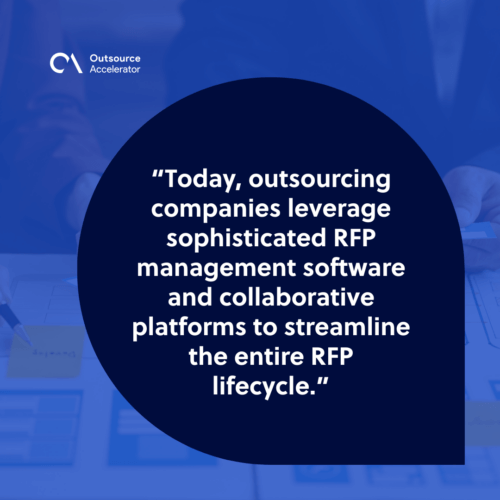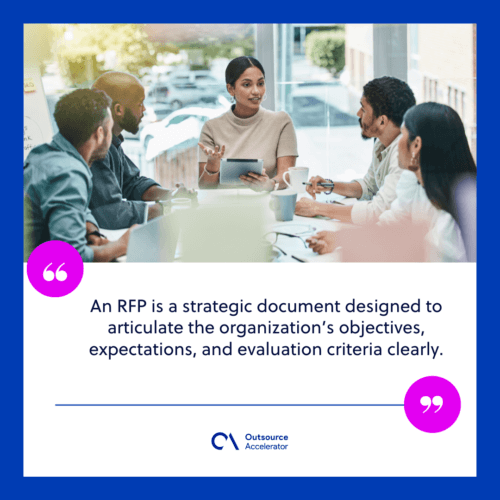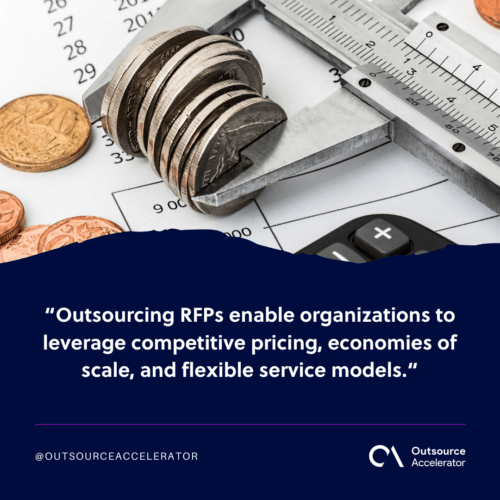Outsourcing RFPs: Maximizing efficiency in business operations

Outsourcing has emerged as a key strategy for organizations looking to optimize their operations, expand their capabilities, and drive growth.
At the heart of this strategic approach lies the Request for Proposal (RFP) process, a critical step in selecting the right partners to fulfill specific business needs and objectives.
What is a Request for Proposal (RFP)?
A Request for Proposal (RFP) is a formal document issued by a company or organization to solicit bids or proposals from qualified vendors, suppliers, or service providers.
The purpose of an RFP is to outline the organization’s specific requirements, needs, and objectives for a particular project, service, or procurement initiative.
Understanding outsourcing RFPs
For outsourcing companies, crafting and responding to RFPs represent pivotal moments in the pursuit of new business opportunities and the expansion of their client base.
The landscape of outsourcing RFPs has undergone a transformation in recent years, driven by shifting market dynamics, technological advancements, and changing client expectations.
Traditionally, RFPs were often viewed as cumbersome, time-consuming endeavors characterized by lengthy documents and rigid processes. However, the rise of digital platforms, cloud-based solutions, and automation tools revolutionized the way RFPs are created, distributed, and evaluated.
Today, outsourcing companies leverage sophisticated RFP management software and collaborative platforms to streamline the entire RFP lifecycle – from initial drafting and vendor selection to proposal evaluation and contract negotiation.
These digital solutions not only enhance efficiency and transparency but also empower organizations to engage with a broader spectrum of potential partners on a global scale.
Key components of successful outsourcing RFPs
A well-crafted outsourcing RFP is more than just a laundry list of requirements, It is a strategic document designed to articulate the organization’s objectives, expectations, and evaluation criteria clearly.
To maximize the effectiveness of outsourcing RFPs, focus on several key components:
1. Concise objectives
Define the project scope, objectives, and desired outcomes with clarity and precision.
Communicate the organization’s strategic priorities and performance metrics to ensure alignment with potential service providers.
2. Comprehensive requirements
Outline specific functional, technical, and operational requirements that vendors must address in their proposals.
Provide sufficient context and background information to enable vendors to formulate tailored solutions that meet the organization’s unique needs.
3. Evaluation criteria
Establish transparent evaluation criteria and weighting factors to assess vendor proposals objectively.
Consider factors such as technical expertise, industry experience, pricing, scalability, and cultural fit when evaluating potential partners.
4. Communication protocols
Establish clear communication protocols and timelines to facilitate dialogue between the organization and prospective vendors.
Encourage open collaboration and provide ample opportunities for vendors to seek clarification and address concerns throughout the RFP process.
5. Flexibility and adaptability
Recognize that the outsourcing landscape is dynamic and evolving. Embrace flexibility and adaptability in outsourcing RFP development and evaluation to accommodate changing market conditions, emerging technologies, and evolving client requirements.
5 Benefits of outsourcing RFPs for businesses
Outsourcing RFPs offer a myriad of benefits for businesses seeking to optimize their operations, mitigate risks, and drive innovation.
1. Access to specialized expertise
By soliciting proposals from a diverse pool of service providers, organizations can tap into specialized expertise, industry insights, and innovative solutions that may not be available in-house.
2. Cost optimization
Outsourcing RFPs enable organizations to leverage competitive pricing, economies of scale, and flexible service models to optimize costs and maximize return on investment (ROI).
3. Risk mitigation
Through rigorous vendor evaluation and due diligence, organizations can mitigate risks associated with service delivery, performance, and compliance, thereby safeguarding their reputation and financial interests.
4. Scalability and flexibility
Outsourcing RFPs provide organizations with the flexibility to scale resources up or down in response to changing business demands, market conditions, and strategic priorities.
5. Focus on core competencies
By outsourcing non-core functions and activities, organizations can refocus internal resources and talent on core business activities, strategic initiatives, and value-added activities that drive growth and competitive advantage.
The future of outsourcing RFPs
The role of outsourcing RFPs as catalysts for strategic partnerships and business transformation has never been more critical.
By embracing digital innovation, fostering collaboration, and prioritizing transparency and accountability, organizations can unlock new opportunities, drive operational excellence, and achieve sustainable growth in an increasingly competitive landscape.
Success hinges not only on the quality of the RFPs but also on the ability to forge meaningful partnerships that deliver value, innovation, and long-term success.










 Independent
Independent




